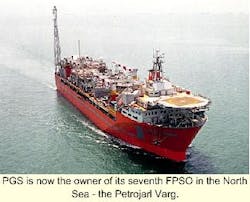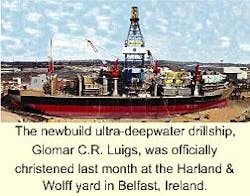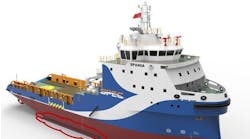PGS is on the way to becoming one of the leaders in the FPSO (floating production, storage, and offloading vessel) market. Under two separate agreements, the company negotiated on behalf of the Varg license owners (Saga 35%; Statoil 65%) for the purchase of the Varg FPSO, while at the same time securing a minimum three-year contract to operate the vessel. The vessel was sold for $350 million and PGS will receive a day rate of $177,000, in addition to the operating expense for operating the vessel for the first three-year period after which the rate dips to $162,000. The contract also allows for Saga and Statoil to lease the vessel for an unlimited period of time.
The Varg FPSO, which was purpose-built for the field, has been producing from the North Sea field since December. The vessel will now be renamed the Petrojarl Varg and will be the only contractor owned and operated FPSO working in Norway. With this acquisition, PGS becomes the largest FPSO operator in the North Sea area with seven FPSO opreations, four of which are owned by PGS. The vessel will be operated through the PGS subsidiary Golar Nor Offshore.
Fourth EVA delivered
Noble has delivered its fourth EVA-4000 semisubmersible conversion. The Noble Amos Runner was delivered from the HAM Marine shipyard in Pascagoula, went through mooring and sea trials, and was accepted by operators Kerr-McGee, Marathon, and Murphy in mid-August. The rig has since begun working on a five-year contract in the Gulf of Mexico.
The Noble Amos Runner is equipped to drill in 6,600 ft water depths fully-moored. This is number four of five EVA conversions which entails converting and upgrading a proven design three-column submersible to a 6,000 ft moored or 8,800 ft DP semisubmersible.
The next, and last to come, for now, is the Noble Max Smith. The rig is under construction at the HAM Marine yard, where all the conversions were done, and is due out in December. The Noble Max Smith currently is under a letter of intent with Amerada Hess and UPRC for a five-year contract in the Gulf of Mexico. Noble has had tremendous success with the conversions. All four EVA units have been delivered in a timely fashion, and one, the Noble Paul Wolff has broken the world water depth drilling record, at 8,017 ft, off Brazil.
TDI-Halter delivers two
TDI-Halter has accomplished two "firsts" with one delivery. The company has delivered its first rig from its Pascagoula, Mississippi yard, and it is the first rig of its design to be completed.
In a ceremony at the company's Pascagoula yard, Don Covington, President of TDI-Halter, presented Patricio Alvarez Morphy, Owner of Perforadora Central, S.A. DE C.V. of Mexico, with the newbuild Tonala LeTourneau Super 116C jackup, the first rig to be delivered based on this design.
The Super 116C design is about 20% larger in size than the traditional LeTourneau 116C, one of the industry's staples for jackup designs. The rig also features a completely re-designed type of leg developed by LeTourneau and a different jacking system. One other Super 116C is under construction at this time for Chiles Offshore and is currently at the Amfels yard in Brownsville, Texas.
The Tonala is designed for harsh environments and has a 70-ft cantilever to allow for both exploration and development drilling. The original design specified a 50-ft cantilever, but Perforadora opted for the additional capability to add more versatility as well as compete with the workover rigs. The hull of the jackup measures 243 ft in length by 206 ft in width. The rig is capable of drilling in 350 ft water depths on three 477-ft legs set on spud cams 46-ft in diameter.
The Tonala is the third addition to Perforadora's fleet, which includes two other jackups. The rig will work for Pemex in the Bay of Campeche for about two and a half years on the Cantarell project and surrounding areas.
Global Marine christens first of two drillships
Last month, Global Marine christened the first of two ultra-deepwater drillships - Glomar C.R. Luigs. The newbuild was constructed at the Harland & Wolff yard in Belfast, Ireland, on time and on budget. The drillship is outfitted for 9,000 ft water depth operation based on a 12,000 ft design.
The rig is expected to depart Belfast this month for sea trials and then travel to the Gulf of Mexico for its initial three-year contract with BHP. Construction on the sister vessel, Glomar Jack Ryan, is reportedly also on schedule and delivery is expected in the first quarter of next year. The Glomar Jack Ryan will be outfitted to 8,000 ft and work for Exxon on a three-year contract, most likely offshore West Africa.
New heavy lifts
Offshore Heavy Transport is set to deliver two Marlin-class heavy lift vessels this month, the Black Marlin and Blue Marlin. The vessels will measure 712 ft on length and 137.8 ft in breadth and will be the largest of their kind in the world. The stowable deck area is 584.6 ft by 137.8 ft, providing 77,672 sq ft, large enough to stow three Marathon LeTourneau 116-C class jackups simultaneously.
The Marlin ships have nearly twice the deadweight and stability capacity than the existing heavy lift fleet to accommodate the larger and heavier structures needed for deepwater operations. The deck has also been specially designed to withstand extremely heavy concentrated loads such as semisubmersibles and TLPs. The deck was designed to handle an average evenly distributed pressure of 27.5 tons/sq meter.
The hulls of the vessels were also designed for better motions, by incorporating more a ship-shape design rather than the traditional wide flat barge. This allows for a smoother flow of water and offers a safer and more cost effective transit.
The first assignment for the vessels will be the launching of R&B Falcon's two newbuild semisubmersibles: the Deepwater Nautilus and Deepwater Horizon.





